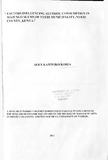| dc.description.abstract | Alcohol consumption has become a menace in Kenya and especially among the middle and low income earners. Excessive alcohol consumption has rendered many young men both socially and economically unproductive as most of their time is spent hopping from one drinking den to another in search of the liquor. The magnitude ofthe problem had soared to the point of forcing the parliament to pass the Alcohol Drinks Control Act of 20 1 0 intended to regulate alcohol consumption in Kenya. This study was therefore conducted to establish the factors that lead to alcohol consumption in Majengo Slums, Nyeri Municipality, Nyeri County, Kenya.
The literature studied revealed an outcry from the residents and leaders who had complained over the increase in the number of alcohol dens in the area and some of the reasons why alcohol was preferred. The following were the objectives of the study: to examine how type of occupation and income level influences alcohol consumption in Majengo Slums, Nyeri Municipality, Nyeri County, Kenya; to determine how the level of education influences alcohol consumption in Majengo Slums, Nyeri Municipality, Nyeri County, Kenya; to establish how cost and access to alcohol influences alcohol consumption in Majengo Slums, Nyeri Municipality, Nyeri County, Kenya; to examine how religion influences alcohol consumption in Majengo Slums, Nyeri Municipality Nyeri County, Kenya and; to assess how social factors such as gender, marital status and age influences alcohol consumption in Majengo Slums, Nyeri Municipality, Nyeri County, Kenya.
The study used descriptive survey research design carried on 200 residents who were selected using clustered random sampling. The study adopted questionnaires as the research instrument and were administered with the help of a research assistant. The data collected was analyzed using descriptive analysis method and the findings were presented using tables and charts. The main findings of the study revealed that low level of education, joblessness, low cost and ease of access of alcohol significantly led to excessive alcohol consumption in the area. Similarly, the study revealed that married men, particularly those aged between 18 and 28 years, were more vulnerable to excessive alcohol consumption than their female counterparts. Religion was insignificant in alcohol reduction as more Christians consumed alcohol compared to atheists contrary to the expectations.
The study recommends that income generating projects ought to be started in the area to engage the idle youth in productive activities. Secondly, the study recommends that awareness campaigns ought to be started to sensitize the youth, especially those aged between 18 and 28 years, on the demerits of alcohol consumption and the need to further their education to a level that can give them a reliable and legitimate source of income. Thirdly, the Alcohol Law should be fully implemented in the area in order to regulate excessive alcohol consumption through restricting access to alcohol. With regard to the type of alcohol consumed, the government should totally barn the cheap illicit brews from the area since they are easily available despite their detrimental effects.
Lastly, religious groups ought to restructure themselves so as to remain relevant in curbing social evils such as excessive alcohol consumption among the followers. The findings of this study are very useful to the government and other policy makers in mitigating the alcoholism problem in Majengo Slums ofNyeri Municipality, Nyeri Kenya and other alcohol tom areas in Kenya. | en_US |

